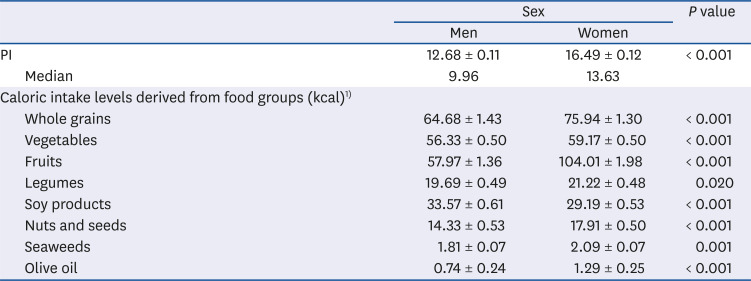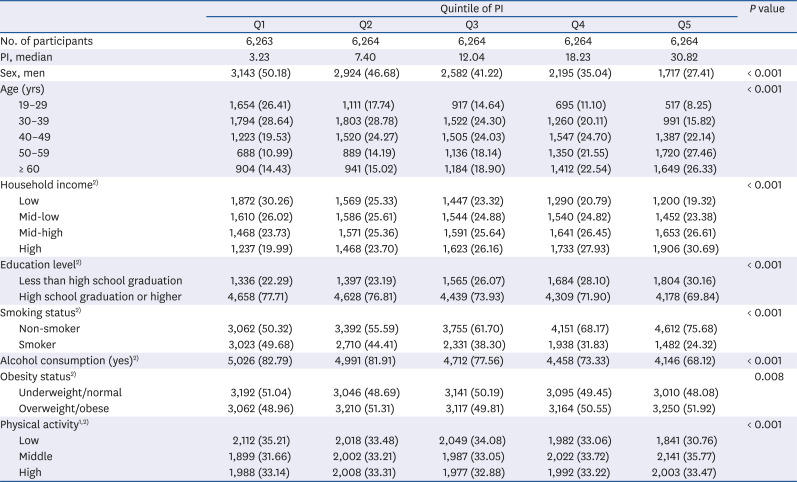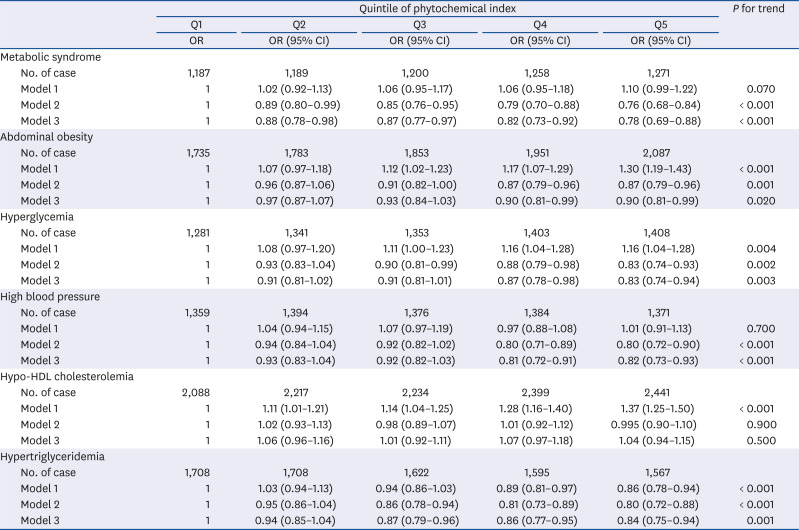1. Martinez KB, Mackert JD, McIntosh MK. Polyphenols and intestinal health. In : Watson RR, editor. Nutrition and Functional Foods for Healthy Aging. Cambridge: Academic Press;2017. p. 191–210.
2. Surh YJ. Cancer chemopreventive effects of dietary phytochemicals. J Korean Assoc Cancer Prev. 2004; 9:68–83.
3. Kocyigit A, Guler EM, Dikilitas M. Role of antioxidant phytochemicals in prevention, formation and treatment of cancer. In : Cristiana F, editor. Reactive Oxygen Species (ROS) in Living Cells. London: InterchOpen;2018. p. 21–45.
4. Liu RH. Potential synergy of phytochemicals in cancer prevention: mechanism of action. J Nutr. 2004; 134:3479S–3485S. PMID:
15570057.

5. Zhang H, Tsao R. Dietary polyphenols, oxidative stress and antioxidant and anti-inflammatory effects. Curr Opin Food Sci. 2016; 8:33–42.

6. Liu S, Manson JE, Stampfer MJ, Rexrode KM, Hu FB, Rimm EB, Willett WC. Whole grain consumption and risk of ischemic stroke in women: a prospective study. JAMA. 2000; 284:1534–1540. PMID:
11000647.
7. Wang PY, Fang JC, Gao ZH, Zhang C, Xie SY. Higher intake of fruits, vegetables or their fiber reduces the risk of type 2 diabetes: a meta-analysis. J Diabetes Investig. 2016; 7:56–69.
8. Juan J, Liu G, Willett WC, Hu FB, Rexrode KM, Sun Q. Whole grain consumption and risk of ischemic stroke: results from 2 prospective cohort studies. Stroke. 2017; 48:3203–3209. PMID:
29127271.
9. Aune D, Keum N, Giovannucci E, Fadnes LT, Boffetta P, Greenwood DC, Tonstad S, Vatten LJ, Riboli E, Norat T. Nut consumption and risk of cardiovascular disease, total cancer, all-cause and cause-specific mortality: a systematic review and dose-response meta-analysis of prospective studies. BMC Med. 2016; 14:207. PMID:
27916000.

10. Bazzano LA, He J, Ogden LG, Loria C, Vupputuri S, Myers L, Whelton PK. Legume consumption and risk of coronary heart disease in US men and women: NHANES I Epidemiologic Follow-up Study. Arch Intern Med. 2001; 161:2573–2578. PMID:
11718588.
11. Parker ED, Liu S, Van Horn L, Tinker LF, Shikany JM, Eaton CB, Margolis KL. The association of whole grain consumption with incident type 2 diabetes: the Women's Health Initiative Observational Study. Ann Epidemiol. 2013; 23:321–327. PMID:
23608304.
12. Villegas R, Shu XO, Gao YT, Yang G, Elasy T, Li H, Zheng W. Vegetable but not fruit consumption reduces the risk of type 2 diabetes in Chinese women. J Nutr. 2008; 138:574–580. PMID:
18287369.

13. Albert CM, Gaziano JM, Willett WC, Manson JE. Nut consumption and decreased risk of sudden cardiac death in the Physicians' Health Study. Arch Intern Med. 2002; 162:1382–1387. PMID:
12076237.

14. Misirli G, Benetou V, Lagiou P, Bamia C, Trichopoulos D, Trichopoulou A. Relation of the traditional Mediterranean diet to cerebrovascular disease in a Mediterranean population. Am J Epidemiol. 2012; 176:1185–1192. PMID:
23186748.

15. McCarty MF. Proposal for a dietary “phytochemical index”. Med Hypotheses. 2004; 63:813–817. PMID:
15488652.

16. Bahadoran Z, Golzarand M, Mirmiran P, Saadati N, Azizi F. The association of dietary phytochemical index and cardiometabolic risk factors in adults: Tehran Lipid and Glucose Study. J Hum Nutr Diet. 2013; 26(Suppl 1):145–153.

17. Golzarand M, Bahadoran Z, Mirmiran P, Sadeghian-Sharif S, Azizi F. Dietary phytochemical index is inversely associated with the occurrence of hypertension in adults: a 3-year follow-up (the Tehran Lipid and Glucose Study). Eur J Clin Nutr. 2015; 69:392–398. PMID:
25387902.

18. Golzarand M, Mirmiran P, Bahadoran Z, Alamdari S, Azizi F. Dietary phytochemical index and subsequent changes of lipid profile: a 3-year follow-up in Tehran Lipid and Glucose Study in Iran. ARYA Atheroscler. 2014; 10:203–210. PMID:
25258636.
19. Abshirini M, Mahaki B, Bagheri F, Siassi F, Koohdani F, Sotoudeh G. Higher intake of phytochemical-rich foods is inversely related to prediabetes: a case-control study. Int J Prev Med. 2018; 9:64. PMID:
30147853.

20. Yuan C, Lee HJ, Shin HJ, Stampfer MJ, Cho E. Fruit and vegetable consumption and hypertriglyceridemia: Korean National Health and Nutrition Examination Surveys (KNHANES) 2007–2009. Eur J Clin Nutr. 2015; 69:1193–1199. PMID:
26014266.

21. Lee YJ, Nam GE, Seo JA, Yoon T, Seo I, Lee JH, Im D, Bahn KN, Jeong SA, Kang TS, Ahn JH, Kim DH, Kim NH. Nut consumption has favorable effects on lipid profiles of Korean women with metabolic syndrome. Nutr Res. 2014; 34:814–820. PMID:
25238912.

22. Hong SA, Kim MK. Relationship between fruit and vegetable intake and the risk of metabolic syndrome and its disorders in Korean women according to menopausal status. Asia Pac J Clin Nutr. 2017; 26:514–523. PMID:
28429918.
23. Kweon S, Kim Y, Jang MJ, Kim Y, Kim K, Choi S, Chun C, Khang YH, Oh K. Data resource profile: the Korea National Health and Nutrition Examination Survey (KNHANES). Int J Epidemiol. 2014; 43:69–77. PMID:
24585853.

24. Ainsworth BE, Haskell WL, Leon AS, Jacobs DR Jr, Montoye HJ, Sallis JF, Paffenbarger RS Jr. Compendium of physical activities: classification of energy costs of human physical activities. Med Sci Sports Exerc. 1993; 25:71–80. PMID:
8292105.

29. Grundy SM, Cleeman JI, Daniels SR, Donato KA, Eckel RH, Franklin BA, Gordon DJ, Krauss RM, Savage PJ, Smith SC Jr, Spertus JA, Costa F. American Heart Association. National Heart, Lung, and Blood Institute. Diagnosis and management of the metabolic syndrome: an American Heart Association/National Heart, Lung, and Blood Institute Scientific Statement. Circulation. 2005; 112:2735–2752. PMID:
16157765.
30. Bahadoran Z, Mirmiran P, Tohidi M, Azizi F. Dietary phytochemical index and the risk of insulin resistance and β-cell dysfunction: a prospective approach in Tehran Lipid and Glucose Study. Int J Food Sci Nutr. 2015; 66:950–955. PMID:
26600067.

31. Reaven GM. Banting lecture 1988. Role of insulin resistance in human disease. Diabetes. 1988; 37:1595–1607. PMID:
3056758.

32. Wilcox G. Insulin and insulin resistance. Clin Biochem Rev. 2005; 26:19–39. PMID:
16278749.
33. Schrezenmeir J. Hyperinsulinemia, hyperproinsulinemia and insulin resistance in the metabolic syndrome. Experientia. 1996; 52:426–432. PMID:
8641379.

34. Bahadoran Z, Mirmiran P, Azizi F. Dietary polyphenols as potential nutraceuticals in management of diabetes: a review. J Diabetes Metab Disord. 2013; 12:43. PMID:
23938049.

35. Zhang B, Kang M, Xie Q, Xu B, Sun C, Chen K, Wu Y. Anthocyanins from Chinese bayberry extract protect β cells from oxidative stress-mediated injury via HO-1 upregulation. J Agric Food Chem. 2011; 59:537–545. PMID:
21166417.

36. Park CE, Kim MJ, Lee JH, Min BI, Bae H, Choe W, Kim SS, Ha J. Resveratrol stimulates glucose transport in C2C12 myotubes by activating AMP-activated protein kinase. Exp Mol Med. 2007; 39:222–229. PMID:
17464184.

37. Holubková A, Penesová A, Šturdík E, Mošovská S, Mikušová L. Phytochemicals with potential effects in metabolic syndrome prevention and therapy. Acta Chim Slov. 2012; 5:186–199.









 PDF
PDF Citation
Citation Print
Print



 XML Download
XML Download